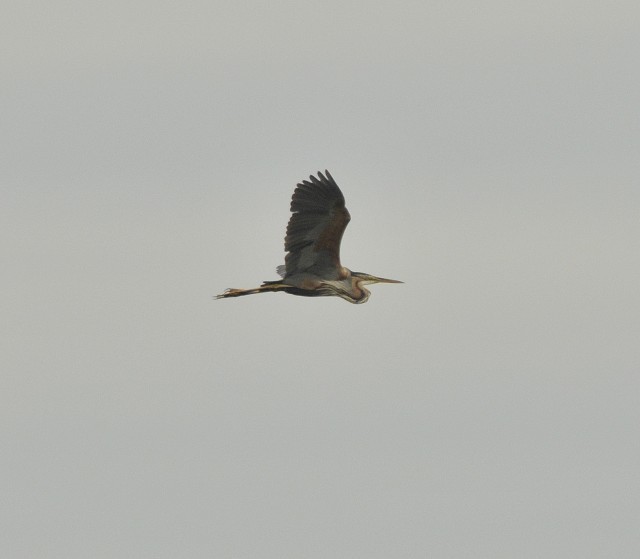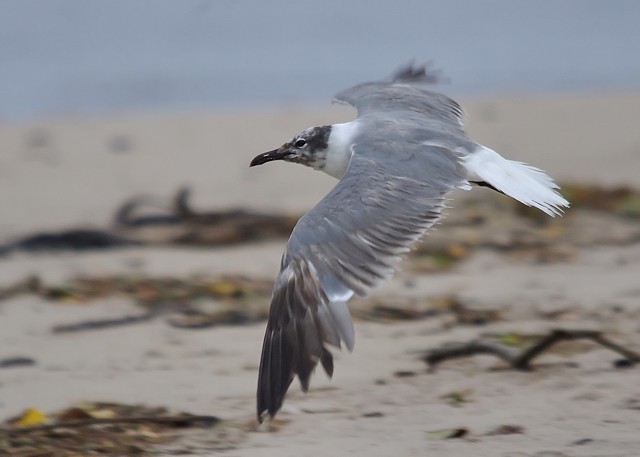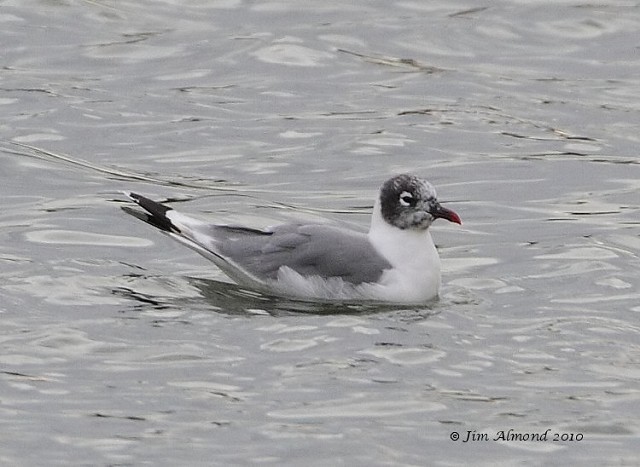The week at a glance
- House Finch in Devon
- Putative House Crow in Lothian reidentified
- Escaped Purple Gallinule in Clwyd
The week was very quiet for quality rarities, with the dubious highlights being controversial, questionable or downright duff.
The contentious House Finch was seen on and off at East Prawle (Devon) all week and is looking decidedly red now as its moult advances rapidly. A belated, and anecdotal, report also surfaced that suggested that the bird may have frequented a garden in Lizard village (Cornwall) before arriving at East Prawle.

House Finch, East Prawle, Devon (Photo: Pat Mayer)
The questionable House Crow saga came to an end when further photos of the bird showed it to be an unusually pale juvenile Jackdaw.

Jackdaw, Edinburgh, Lothian (Photo: anon)
The downright duff was a Purple Gallinule that appeared in the glamorous location of a ditch next to a building site at Saltney (Clwyd) on 30th. It caused the usual fuss over origins and acceptability until its owners turned up on 1st and proceeded to chase it up and down the ditch for a while before popping it back into its cage.

Purple Gallinule, Saltney, Clwyd (Photo: Rob Smallwood)
Thankfully the supporting cast of scarcities and breaking news was enough to keep the week interesting. Of continued interest were the nine Ruddy Shelduck, which this week moved to Montrose Basin (Angus & Dundee) on 30th–3rd at least. These birds are often under-reported, so any real patterns are masked, but others were a single at Hornsea Mere (East Yorkshire) on 1st and three flying up the Humber past Spurn (East Yorkshire) on 4th.

Ruddy Shelduck, Montrose Basin, Angus & Dundee (Photo: Peter)
With the breeding season over, it was interesting to see good numbers of Garganey around, with several small dispersing gatherings. Some of the largest groups were fours at Willington GP (Derbyshire), Grove Ferry (Kent) and Rutland Water (Leicestershire).
The usual long-staying wildfowl remained, including the female Ferruginous Duck at Minsmere (Suffolk), the two moulting drake Ring-necked Ducks in Fife, at Angle Park and from Loch Gelly and the two hybrid Pochard × Tufted Duck at Stoke Newington (London).
On the sea, an eclipse drake King Eider was at Wester Quarff (Shetland) on 31st, with two adult drake Surf Scoters again at Blackdog (Aberdeenshire) on 29th and 4th and other drakes at Lunan Bay (Angus & Dundee) on 30th and at West Burra (Shetland) on 4th.
There seem to be fewer inland Common Scoters now, with the only big gathering being nine at Stocks Reservoir (Lancashire) on 3rd. More impressive was a raft of 143 Velvet Scoters off Musselburgh (Lothian) on 4th.
Late-summer Quail were very vocal, with the highest counts reported of four at Marcross (Glamorgan), three at Felkington (Northumberland) and three at Bempton Cliffs (East Yorkshire).
The only Cory's Shearwater reported was one in the bay at Thurlestone (Devon) on 31st, and the first Great Shearwater of the year passed Pendeen (Cornwall) on 3rd, followed by a report of one past Morte Point (Devon) on 4th. Peak counts of Sooty Shearwaters in the south and west included 26 past Kilcummin Head (Co. Mayo) on 4th, 24 past Pendeen (Cornwall) on 4th and 22 past Malin Head (Co. Donegal) on 1st. Aside from birds in the south and west, other records included three past Flamborough Head (East Yorkshire) on 30th and 2nd and singles past Whitburn (Durham) and Spurn (East Yorkshire) on 31st and Hopton-on-Sea (Norfolk) on 4th.
Balearic Shearwater numbers continued to build, with 83 off Portland Bill (Dorset) on 4th and 51 past Porthgwarra (Cornwall) on 30th. Away from the southwest, others were reported past Saltcoats (Ayr), three past Bridges of Ross (Co. Clare) and two off Balbriggan (Co. Dublin). These numbers are dwarfed by those recently recorded on the French side of the Channel, with a gathering of 4,630 birds in the Bay of Lannion on 30th July.
Back on land, or over land, a Black Stork was seen in flight at Burrator Reservoir (Devon) on 2nd with a juvenile then over Sevenoaks Wildfowl Reserve (Kent) on 4th.
There were no reports of the Somerset Little Bitterns this week, though good news came from Dungeness (Kent), where a juvenile Purple Heron was seen on 3rd and 4th, confirming the successful breeding there. The long-staying Great White Egret also remained at Dungeness all week, and a great Mediterranean waterbird hat-trick came in the form of a Cattle Egret that roved around the site on 1st–3rd. Other Cattle Egrets included the bird at Doxey Marshes (Staffordshire) on 29th, one at Ingrebourne Valley (London) on 30th and one at Eyebrook Reservoir (Leicestershire) on 3rd–4th. The French colour-ringed Great White Egret also remained at Shapwick Heath (Somerset) to 31st.

Purple Heron, Dungeness RSPB, Kent (Photo: Stephen Allen)

Cattle Egret, Eyebrook Reservoir, Leicestershire and Rutland (Photo: Dave Hutton)
Other fantastic breeding news was released this week, as Natural England confirmed the successful fledging of six Spoonbills from four nests at Holkham (Norfolk). Two further pairs are still feeding young in what is the first multiple breeding in modern times. These birds no doubt accounted for the count of 14 in Blakeney Harbour (Norfolk), with other site maxima of 16 at Havergate Island (Suffolk), seven at Middlebere (Dorset) and seven at Arne (Dorset). Sadly lacking a partner, the Glossy Ibis was again reported at Tacumshin (Co. Wexford) on 2nd and 4th.

Adult Spoonbill at the nest with a chick at Holkham NNR (photo: Andrew Bloomfield)
Numbers of migrant Ospreys picked up, with a minimum of nine birds along the south coast, including at least four in Dorset and three in Hampshire. The only other raptor of interest was a French wing-tagged Montagu's Harrier at Tacumshin (Co. Wexford) on 1st.
Another early Spotted Crake was reported Farlington Marshes (Hampshire) on 30th and a juvenile was sadly found dead on a road at Ugborough (Devon) on 3rd.
On the wader front, a migrant Stone Curlew at Steart (Somerset) on 1st and an adult Pacific Golden Plover was at Loch Bornish, South Uist (Outer Hebrides) on 4th — could this be the Lewis bird from early June?
A Semipalmated Sandpiper at Port Carlisle (Cumbria) on 29th–3rd caused some debate. Those looking at photos online questioned whether this was just a Little Stint, whilst those in the field had a different view and eventually confirmed the palmations between the toes. Pectoral Sandpipers were still in evidence, with the bird at Maer Lake (Cornwall) remaining to 2nd, along with 3 Wood Sandpipers and one at Elmley Marsh (Kent) on 31st–1st, with 21 Spotted Redshanks. The White-rumped Sandpiper stayed at Tacumshin (Co. Wexford) to 2nd, and in Aberdeenshire a Buff-breasted Sandpiper was with Golden Plovers at Collieston on 3rd–4th.

Semipalmated Sandpiper, Port Carlisle, Cumbria (Photo: Craig Shaw)
New in were a Lesser Yellowlegs at Inner Marsh Farm (Cheshire) on 31st–4th, with three Wood Sandpipers, and a Long-billed Dowitcher at Caerlaverock (Dumfries & Galloway) briefly on morning of 2nd. This may well be the same bird seen at the end of April at Caerlaverock. Assuming it is, it is the fifth for the county, with three of the previous records from Caerlaverock (in 1980, 1985 and 1990).
Good counts of common passage waders included 10 Green Sandpipers at Cantley Beet Factory (Norfolk) and 10 Spotted Redshanks at Vange Marshes (Essex), and inland Turnstone were at sites in Northamptonshire, Staffordshire, Surrey, Leicestershire and Kent, and Sanderling at Draycote Water (Warwickshire) and Belvide Reservoir (Staffordshire).
Back at sea, a Grey Phalarope was seen on the pelagic off the Isles of Scilly on 30th, with Pomarine Skuas past Carnsore Point (Wexford), Flamborough Head (East Yorkshire) and Whitburn (Durham), and seven past Kilcummin Head (Co. Mayo) on 4th.
Only a few big white-winged gulls remained, with immature Glaucous Gulls at Bridges of Ross (Co. Clare) on 31st and Ferry Point (Co. Waterford) on 2nd. The only records of Iceland Gull were from Youghal (Co. Cork), on 31st and 2nd. Also in Ireland, the first-summer American Herring Gull stayed at Blennerville (Co. Kerry) to 31st.
Yellow-legged Gulls are regular at many sites now, with maximum counts of 42 at Paxton Pits (Cambridgeshire), 40 at Farmoor Reservoir (Oxfordshire) and 40 at Rainham Marshes (London). Single Caspian Gulls were at just nine sites, with two at Nar Valley Fisheries (Norfolk) on 3rd.
From the west, the moulting second-summer Laughing Gull was at Ballycastle (Co. Antrim) to 4th, and the adult Franklin's Gull came in to roost at Chasewater (Staffordshire) on evenings to 30th. Presumably the same bird was then around Gailey Reservoirs (Staffordshire) on 31st–1st. Last of the gulls were adult Sabine's Gulls seen off the Scrabster-Stromness ferry on 31st, and past Malin Head (Co. Donegal) and Annagh Head (Co. Mayo) on 1st.

Laughing Gull, Ballycastle, Antrim (Photo: Ronan McLaughlin)

Franklin's Gull, Gailey Reservoirs, Staffordshire (Photo: Jim Almond)
Passage Roseate Terns were being picked up at coastal sites, with the counts including seven at Alnmouth (Northumberland), six at East Chevington (Northumberland) and four at South Gare (Cleveland), and two birds still at Lodmoor (Dorset). More of an attraction was the juvenile Whiskered Tern that performed admirably at Saltholme (Cleveland) to 4th.

Whiskered Tern, Saltholme RSPB, Cleveland (Photo: Ian Forrest)
Mid-summer Alpine Swifts are rather unusual, so one at Burwick, South Ronaldsay (Orkney) on 3rd–4th was a surprise. Migrant warblers continued to appear, with showy Wood Warblers at Sandwich Bay (Kent) to 30th, in Regent's Park (London) on 2nd–4th and others in Hertfordshire and Essex. Also new in were two Icterine Warblers at Sumburgh (Shetland) on 3rd, though a brief Hippolais warbler at Hilbre Bird Observatory (Cheshire) on 4th remained unidentified. Last but not least of the migrants were two Nightingales ringed at Landguard Bird Observatory (Suffolk) on 3rd.
Photo of the Week

Common Kingfisher, Germany (Photo:
Siegbert Werner)
Unusually, this week's strongest image features the same species as last week. Both images have been captured after the photographers have waited patiently for wild Common Kingfishers to do something interesting and both have required great photographic skill to achieve. It's instructive, however, to look at the differences between these two images and the methods used in their creation. Last week's image was a 100% natural capture taken in response to a once-in-a-lifetime event. This week's image, taken by Siegbert Werner, uses a man-made setup to enable an otherwise unobtainable image that follows the bird's dive beneath the surface. Using an established photography technique that Siegbert has described in full detail, the result is a stunning, near-monochrome action shot that freezes the submerged bird amidst a shoal of its intended prey. The latter technique creates a more predictable situation, but still requires expert camera skills and perfect timing. The two images show how, by approaching their subject in different ways, bird photographers can produce equally impressive — but very different — results.
Other notable photos

Little Owl, Qatar (Photo:
Dileep Kumar)

Marsh Harrier, Cley Marshes NWT, Norfolk (Photo:
Andrew J Haynes)

Cuckoo, Otmoor RSPB, Oxfordshire (Photo:
Peter Walkden)

Black-tailed Godwit, Oare Marshes NR, Kent (Photo:
Ian Curran)

Spoonbill, Oare Marshes NR, Kent (Photo:
Steve Ashton)

Golden Plover, Levenwick, Mainland, Shetland (Photo:
James Wood)

Puffin, Farne Islands, Northumberland (Photo:
Matt Latham)

Sandwich Tern, Farne Islands, Northumberland (Photo:
David Whistlecraft)

Common Sandpiper, Druridge Pools, Northumberland (Photo:
Tim Mason)

Siskin, Wayoh Reservoir, Lancashire (Photo:
John Barlow)

Bearded Tit, Cley Marshes NWT, Norfolk (Photo:
Ben the Plumber)

Sand Martin, Attenborough NR, Nottinghamshire (Photo:
John Dickenson)

Tawny Owl, undisclosed site, Cheshire (Photo:
Steve Dolan)

Black Redstart, undisclosed site, Powys (Photo:
Steve Wilce)

Little Grebe, Cley Marshes NWT, Norfolk (Photo:
Chris Upson)

